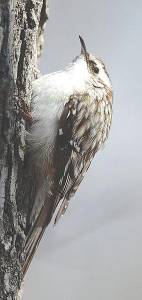Brown Creeper
 In the dim light of early morning, fog hides the far shore of the lake, and all is still. The scene is muted and gray, until the sun breaks through a slit in the clouds, sending a bright spear of light across the water. The fog lifts and the far shore comes into view. In the increasing light, we notice a large round shape waddling through the bushes by the shore, a raccoon out for its early morning exploration. There is something happening out in the cove, too, where a creature is swimming, its wake making a widening “V†on the surface of the water. We look through binoculars and see the flat head of a beaver. Animals usually travel through our yard under cover of darkness, so it’s a treat to be able to see them this morning.
In the dim light of early morning, fog hides the far shore of the lake, and all is still. The scene is muted and gray, until the sun breaks through a slit in the clouds, sending a bright spear of light across the water. The fog lifts and the far shore comes into view. In the increasing light, we notice a large round shape waddling through the bushes by the shore, a raccoon out for its early morning exploration. There is something happening out in the cove, too, where a creature is swimming, its wake making a widening “V†on the surface of the water. We look through binoculars and see the flat head of a beaver. Animals usually travel through our yard under cover of darkness, so it’s a treat to be able to see them this morning.
Birds have been scarce in our yard this autumn, and we hope it is because they are finding natural food in nearby woods and fields. A blue jay occasionally visits our seed feeder, which swings wildly to and fro under his weight, and once in a while tufted titmice come for seeds, but the tube feeder that we filled back in September is still half full, and the block of suet hanging in the suet cage has been nibbled only slightly.
As we sit watching the early morning, something moves just outside the window, on the trunk of the oak tree. We look directly at it but we see nothing. It moves again, and even before we see it clearly we know it is a brown creeper. They are fairly common birds around here, but are so inconspicuous many folks are unaware of them. Only about six inches long, these slim little birds are brown, streaked with gray and white, and are perfectly camouflaged as they perch vertically against the bark of a tree. They make their living by hitching up the side of the tree, using their stiff tail feathers as a prop. Their thin, downward curved bill is just the right tool for probing into crevices in the bark for insects and larvae. They also eat spiders, small invertebrates, seeds, and nuts. Cryptically colored plumage serves them well when a predator is nearby, because the creeper will then flatten itself against the tree, spread its wings out, and remain motionless until the predator has left. Considering how difficult it is to see this little bird when it is moving around a tree trunk, it must be nearly impossible to see it when it is frozen in place.
When I am outdoors, I hear sometimes hear a high, thin “seee†call, and know to look for a brown creeper moving up a nearby tree trunk. It typically moves up and around the trunk in a spiral, then flies down to the base of another tree and starts up again. It is about the same size as our local white-breasted nuthatch, that also gleans food from the bark of trees, but the two species are not related. It is easy to tell them apart because the nuthatch is sharply defined gray, white, and black, and typically goes down a tree headfirst. Brown creepers can be seen in Maine year round. They live throughout North America, from southeastern Alaska to Newfoundland, and as far south as the Gulf of Mexico. They also live in the mountains that extend from Mexico to Nicaragua.
In late spring, brown creepers build curved, hammock shaped nests, tucked behind a piece of loose bark or in some other place on the tree where there is a small space to support it. It may take up to a month to build the nest because it has to be sturdy enough to support five or six eggs. After the youngsters hatch and are ready to leave the nest, they may not be good at flying right away but are adept at climbing up and down the tree trunk.
Daylight has continued to brighten, and our early morning visitors have all moved on. It’s time for us to move on, too, so we leave our seats by the window and go into the kitchen to make our breakfast.


